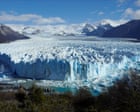
In a world increasingly impacted by climatic and environmental shifts, notable developments in various sectors are shaping the global landscape. From the icy domains of Patagonia to the stadiums of North America, and the resource-rich fields of Angola, diverse events underscore the multifaceted impacts of environmental and energy dynamics on human activities and natural ecosystems.
The majestic Perito Moreno Glacier, situated in Argentina’s Santa Cruz province, has long stood as a symbol of resilience in a warming world. This natural wonder is part of the Patagonian icefields and until recently defied the widespread retreat experienced by many of its glacial counterparts. However, new scientific analyses reveal troubling trends. Over the past seven years, Perito Moreno has experienced considerable ice loss, amounting to 1.92 square kilometers (0.74 square miles) of its ice cover. The glacier is also witnessing a significant annual thinning of up to 8 meters (26 feet). These observations suggest a potential irreversible decline, a sobering reminder of the global warming impact on even the most stable of environments.
While Antarctica and Greenland often draw headlines for their substantial ice losses, changes in regions like Patagonia illustrate that the melting phenomenon is indeed a global occurrence. The concerns extend beyond geographical transformations, encompassing impacts on ecosystems and communities reliant on glacial meltwater. Scientists emphasize the intricate balance of these natural systems and call for increased awareness and research to monitor and mitigate such environmental changes.
As climate considerations influence various sectors, the realm of sports is also adapting to the realities of warming global temperatures. The upcoming 2026 World Cup, set to be partially hosted by the United States, is taking innovative strides to ensure player safety amidst anticipated high temperatures. FIFA President Gianni Infantino has announced the strategic use of indoor, air-conditioned venues for daytime matches, a decision driven by player welfare concerns. This approach was informed by recent experiences at the Club World Cup in the U.S., where players endured challenging conditions in the heat, with temperatures peaking at 35°C (95°F).
Enzo Fernández, a player for Chelsea, reflected on these conditions during a semi-final matchup, describing them as “very dangerous” and attributing dizzy spells to the intense heat. The proactive use of covered stadiums illustrates a broader commitment to health and safety, emphasizing adaptive strategies in international sporting events to create environments conducive to optimal performance and audience comfort.
Beyond adaptation, exploration continues to advance in the energy sector, with notable developments in Angola’s gas industry. The announcement from a consortium led by Azule Energy regarding the discovery of a new gas field highlights significant strides in the country’s resource exploration efforts. This marks Angola’s first well dedicated solely to gas exploration, a momentous occasion that signifies a new chapter in the nation’s energy landscape.
This discovery not only holds promise for Angola’s economic diversification by reinforcing its status as an emerging gas producer but also aligns with global shifts toward natural gas as a more sustainable energy source. The development underscores Angola’s potential role in meeting regional and international energy demands while contributing to cleaner energy initiatives.
These global narratives reveal the complex interplay between environmental phenomena, human innovation, and resource exploration. Each sector’s response to challenges, whether through scientific research, infrastructural adaptation, or energy advancements, speaks to a collective endeavor to navigate an interconnected world. As we observe these changes, the importance of mindful consideration and collaborative solutions remains paramount in shaping a sustainable and resilient future.
Source: {link}
